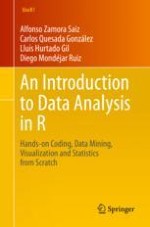2020 | OriginalPaper | Buchkapitel
2. Introduction to R
verfasst von : Alfonso Zamora Saiz, Carlos Quesada González, Lluís Hurtado Gil, Diego Mondéjar Ruiz
Erschienen in: An Introduction to Data Analysis in R
Aktivieren Sie unsere intelligente Suche, um passende Fachinhalte oder Patente zu finden.
Wählen Sie Textabschnitte aus um mit Künstlicher Intelligenz passenden Patente zu finden. powered by
Markieren Sie Textabschnitte, um KI-gestützt weitere passende Inhalte zu finden. powered by
